Have you ever been told that you can’t take vitamin supplements with your medications or that you really need to be careful when doing so? You certainly do need to exercise caution because the combination of vitamins and prescription medication can cause a myriad of problems, but vitamin supplements CAN be beneficial with prescription medications IF you take the right combination. Let’s take a look at a few examples of a potent and beneficial combination of medication and vitamins.
- Antidepressants, such as Zoloft and Lexapro, are well-paired with the B vitamins, particularly vitamins B6 and B12.
- People taking Metformin for type 2 diabetes will do well to take vitamin B12 and fish oil.
- When taking antibiotics, such as Amoxicillin or Ampicillin, taking probiotics is beneficial to restore good gut flora.
- When taking medications to treat osteoporosis, such as Fosamax or Boniva, taking supplements of vitamin D and calcium will help maintain healthy bone structure.
- When taking oral contraceptives, such as Ortho Tri Cyclen or Yasmin, it is beneficial to take vitamin C.
Quality Counts
You can purchase vitamins from online pharmacies, just as you can purchase prescription medications online. You will be able to find them for a lower price in an online pharmacy, allowing you to save money. Just be sure to treat your vitamin supplements with the same respect you would use for your prescription medications. Make sure you are ordering from a legitimate and reputable online pharmacy that has a licensed pharmacist. And remember, purchasing vitamins is not the same as buying generic ibuprofen ($16.00 for 100 400mg tablets) instead of the brand name Advil ($26.00 for 100 400mg tablets), which offer the same pain-fighting power either way.
Expensive vitamins can be of poor quality and brand names can offer the same benefit as generic vitamins. The key is to choose a pharmacy that has a high turnover rate in terms of vitamin sales because vitamins lose their potency when they sit on the shelf for too long. Always check the expiry date before you purchase your vitamins, and once you have them in your home, never take more than you need.
Keep Your Physician in the Loop
As surprising as it might seem, the most important thing to take away with you right now is not the fact that you can take vitamin supplements with the right prescription medications or that you can find vitamin supplements for a lower price in online pharmacies. The most important thing for you to remember is to discuss the situation with your physician if you are planning on taking any vitamin supplements along with your medications. You want to be sure that you are taking the proper combination of medications and vitamins and you will want your doctor to monitor your health every step of the way. Otherwise, you could be undermining the benefits of both your medication and the vitamins and you could be putting your health in jeopardy.
The advance of modern medicine has helped human kind on many levels. The age of the average person has been extended, once deadly diseases are now a minor incontinence and medicine heals wounds that was once life altering. However, this doesn’t mean that all medicine is perfect. Even the most tested medicine reacts differently to each individual person. Sometimes these meds have a reaction that isn’t expected and can harm an individual. When this happens, here is How to Report Adverse Drug Reactions.
The Food and Drug Administration (FDA) is the entity that approves all medicine that comes in and out of the USA. This is who will eventually be contacted about the adverse drug reaction. However, this isn’t the first step.
How to Report Adverse Drug Reactions
Step One
Call a doctor. Get to the hospital, clinic, or private physician immediately! When you feel any bad reaction from drugs or medicine, a doctor should immediately be consulted. The reaction could be mild and cause you know harm, but it also could be deadly with long-lasting effects.
Step Two
Talk to the Doctor about what is happening with the drugs. Your doctor should know your complete medical history. He can tell you if the reaction is normal or if there is more action needed. Tell the physician everything that has been happening to you since the effects started.
Step Three
Ask your doctor about FDA’s Adverse Event Reporting System. Have the doctor describe it to you in detail. Make sure your doctor sends in the right paperwork for the drug used. Follow up with your doctor, physician, or health care provider for updates on this report.
Step Four
Discuss, with your doctor or health care provider, if you need to send the report to the drug manufacturer. If you sent off a report to the FDA, this may not be a necessary step. However, when learning how to report adverse drug reactions properly, it is good to cover all the bases.
Step Five
Send in another report on your own. The FDA has an established process on reporting adverse drug reactions. You can find what is information is required and correct forms by going to the official FDA website. Make sure that the name of the drug, the reaction to the rug, and the dates of the reaction are noted on the forms. You can send the form back via the website or fax it in. The information needed can be found at www.fda.gov under Drugs > Guidance, Compliance & Regulatory Information > Surveillance > FDA Adverse Events Reporting System (FAERS)
In Summary, the steps on how to report adverse drug reactions are:
- Contact your doctor, physician, or health care provider.
- Talk to your Doctor about the reactions you are having.
- Ask them to send in a report to the FDA & follow up on updates.
- Send a report to the Drug Manufacturer.
- Manually send in a report on your own through the FDA website.
About this Angie’s List Expert: Cary Byrd is the president and founder of eDrugSearch.com. Based in San Antonio, eDrugSearch.com is a free cost comparison engine that helps consumers get safe access to affordable medications and advocates licensed online pharmacies as a widely accepted alternative.
In this informative lecture video from the “Pharmacy 101″ class at the University of California-San Francisco, Joe Guglielmo, professor of clinical pharmacy, explores antibiotics and antibiotic resistance. Then (at about the 30-minute mark), Lorie Rice discusses problems with medication errors.
If you think college lectures are dry, you won’t be interested. But it’s geared for a lay audience — so if you want to learn more on these topics from some very knowledgeable people, please check it out.
Unfortunately, when we are contemplating taking a new prescription medication, too many of us don’t think about possible harmful interactions with the other drugs we’re taking. We treat the risk like all the fast-paced warnings at the end of pharmaceutical commercials — we ignore them.
That’s dangerous — and in a world where many of us don’t have long-term relationships with a single doctor or pharmacy, it’s becoming all too common for us to fall into drug regimens where the individual medications either counter each other’s effects or create unexpected, and sometimes even deadly, side effects.
That’s why Health 2.0 sites like DoubleCheckMD and PharmaSurveyor are so valuable; they allow you to enter medications and research possible interactions yourself.
If you don’t want to take the do-it-yourself route, however, the Houston Chronicle recommends the following precautions:
Heidi Bragg, a pharmacist and University of Houston School of Pharmacy professor …recommends two actions to help take control of your own health: keep a list of every prescription, supplement and over-the-counter medicine you take, and use one pharmacy to fill all your prescriptions.
The pharmacy professor said drug interactions are especially significant for elderly patients who often take more medicines.
Bragg said she met with one woman who took four synthetic thyroid medications at one time all prescribed by different doctors, all different dosages and all filled at different pharmacies.
“She could have died,” Bragg said.
Pharmaceutical companies talk fast in commercials when they warn about drug interactions. But for your health’s sake, it’s in your interest to take your time and make sure your regimen is both safe and effective.
Doctors in California and Texas are currently under investigation for illegally prescribing Ledger the painkillers Oxycontin and Vicodin, according to reports.
Whether the individual doctors did anything wrong, however, patients can get in trouble when they go to multiple doctors — which is increasingly the case in today’s world.
That’s why it is important to take the safety of your drug regimen in your own hands through a sophisticated tool like PharmaSurveyor (now in beta) or some of the other drug-interaction tools currently on line, like this one at DoubleCheckMD .
The report from the medical examiner is in: Heath Ledger died from the “the combined effects of oxycodone, hydrocodone, diazepam, temazepam, alprazolam and doxylamine.” The brand names for the drugs that were in Ledger’s system are OxyContin, Valium, Xanax, Restoril, Unisom and Hydrocodone.
To be clear, Ledger didn’t die from an overdose of prescription drugs. He died from Adverse Drug Effects (ADEs) — a fatal reaction to the combination of medications he was taking.
As Dr. Kevin Pho of Kevin, M.D. surmises: “Two narcotics, three benzodiazepines, and one sedating antihistamine. If a single physician was responsible for these prescriptions, that’s a serious error in judgment. It is more likely that Mr. Ledger received multiple prescriptions from different physicians around the world, perhaps not knowing the danger these medications have when taken together.”
You might argue that no one in their right mind would take six different meds, even in prescribed doses, at the same time. But you’d be surprised how many Americans do. The majority of Baby Boomers, in fact, are on a regimen of four to six drugs.
In a world where pharmaceutical companies spend $60 billion annually on advertising and promotion, is it any wonder that we now believe there is a “pill for every ill” — and sometimes six?
Late last year, the FDA reported that ADEs, and deaths associated with them, have nearly tripled in the past decade. The FDA acknowledged at least 15,000 deaths are caused annually by drug effects, and conceded that many more go unreported.
How many more? The Journal of the American Medical Association has estimated that ADEs kill well over 100,000 people each year. Erick Von Schweber, founder of PharmaSURVEYOR, goes further — claiming ADEs are the third leading cause of death in the United States, responsible for more than 200,000 deaths each year. Of these, he says, at least 150,000 could be avoided if patients, their doctors and pharmacists were more careful in determining patient drug regimens.
“If you look at people’s drug regimens,” Von Schweber explains, “when they take not just one drug but multiple drugs, not only do they have interactions among drugs that can be harmful — can be fatal — but also there are risks involved in each individual drug. So even if the drugs are interaction-free, the risk is [compounded].”
“The barrier is complexity,” Von Schweber continues. “The typical senior, on a regimen of eight drugs, can have as many as 40 trillion alternate regimens to choose from that vary widely on ADEs … The patient, their family members and their physicians and pharmacists have had no means to navigate this … no decision support to identify the regimens that make the best trade-offs for the individual patient.”
Von Schweber’s PharmaSURVEYOR, which is in private beta with a launch planned later this year, promises a solution to this problem. Using Semantic Web technologies, the free-to-consumer Web application will take FDA data and combine it with information submitted by users, ensuring them that their drug regimens are safe — or warning them of their dangers. Here’s a sample profile a user might receive:
Until a solution like PharmaSURVEYOR is widely available, however, it is critical for patients to let their doctors know all of the drugs they are taking, as well as the dosages and quantities. Don’t be afraid to get a second opinion — and discuss your regimen with your pharmacist as well.
It seems clear that if Heath Ledger knew the combination of drugs he was taking might kill him, he never would have made such as tragic mistake. Let’s hope Ledger’s death can at least provide a lesson for others.
Heath Ledger could be the latest star to have died from an accidental overdose of prescription drugs. Ledger was taking anti-depressants as well as the “dangerous drug” Ambien at the time of his death, although his autopsy today was inconclusive. While most celebrity drug deaths have been the result of either suicide or the use of illegal drugs, a surprising number of stars have died by accident — from medications you can purchase at the corner pharmacy. Here are 12 of the most famous:

1. MARILYN MONROE. Elton John’s “Candle in the Wind” died from an overdose of sleeping pills — specifically, Nembutal and chloral hydrate [pictured]. Although Monroe’s death was officially listed as a suicide in 1962, many forensic experts and investigators now say the overdose was more likely to have been accidental.

2. ELVIS PRESLEY. Perhaps the most famous prescription-drug abuser of all time, Elvis died in 1977 from an overdose of medications while on the toilet in his Graceland mansion. Presley’s ex-wife wrote: “Presley was taking Placidyls [pictured] to combat severe insomnia in ever increasing doses and later took Dexedrine to counter the sleeping pills’ after effects.” Presley’s personal physician, Dr. George C. Nichopoulos, concluded: “Elvis’s problem was that he didn’t see the wrong in it. He felt that by getting [pills] from a doctor, he wasn’t the common everyday junkie…”

3. JUDY GARLAND. The Wizard of Oz star was found dead in her London bathroom by her husband in 1969. Coroner Gavin Thursdon said the cause of death was an accidental overdose of Seconal [pictured].
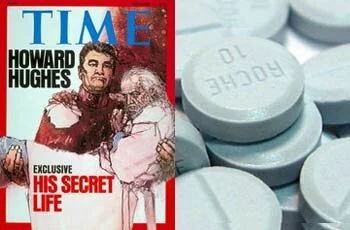
4. HOWARD HUGHES. The germophobic genius and subject of Martin Scorcese’s The Aviator died in 1976 in route to a Houston hospital from his Acalpulco estate. Although the official cause of death was liver failure, his autopsy showed lethal amounts of codeine and valium [pictured] in his system.

5. ANNA NICOLE SMITH. According to Wikipedia, “Ultimately her death [in 2007] was ruled an accidental drug overdose of the sedative chloral hydrate that became increasingly lethal when combined with other prescription drugs in her system, specifically 4 benzodiazepines: Klonopin (Clonazepam), Ativan (Lorazepam), Serax (Oxazepam), and Valium (Diazepam). Furthermore, she had taken Benadryl (Diphenhydramine) and Topamax (Toprimate), an anticonvulsant GABA agonist, which likely contributed to the sedative effect of chloral hydrate and the benzodiazepines.”
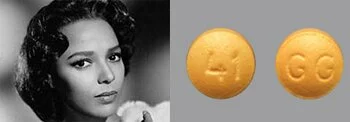
6. DOROTHY DANDRIDGE. The first African-American actress to be nominated for an Academy Award, Dandridge was found dead in West Hollywood in 1965 from an overdose of Imipramine [pictured], a tricyclic antidepressant. It’s believed she improperly combined the medication — which she took for her bipolar disorder — with pain medication she received after breaking an ankle.
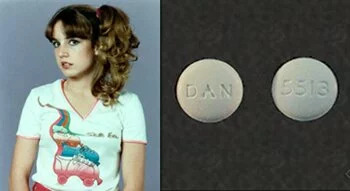
7. DANA PLATO. The long-troubled Diff’rent Strokes star died from an accidental overdose of Vanadom [pictured] and Vicodin at her mother-in-law’s Oklahoma home in 1999.

8. KEITH MOON. The Who drummer died in 1978 from an accidental overdose of Heminevrin [pictured], a medication taken as part of a program to wean him off alcohol.
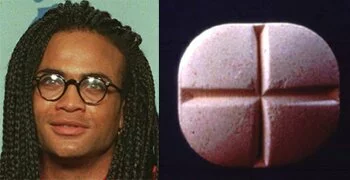
9. ROB PILATUS. The Milli Vanilli star, disgraced after the public learned the music duo did not actually sing on its hit records, died in 1998 of an accidental overdose of a medication (reportedly methadone [pictured]) designed to help him with drug withdrawal symptons.
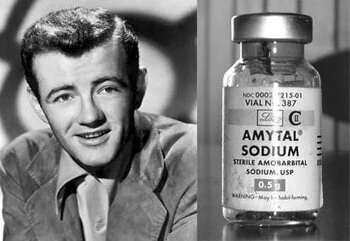
10. ROBERT WALKER. Perhaps the most bizarre accidental prescription-drug death. The star of Hitchcock’s Strangers on a Train died mysteriously in 1951 after being given an injection of the “truth serum” sodium amytal [pictured] by psychiatrists at his home.
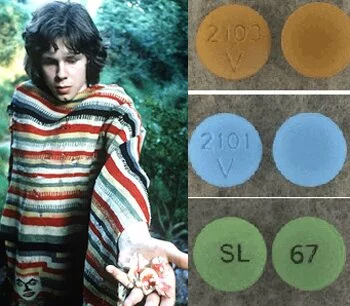
11. NICK DRAKE. The influential singer-songwriter died at his childhood home in the U.K. in 1974 from an accidental overdose of the antidepressant amitriptyline [pictured].
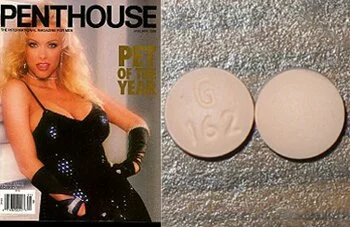
12. PAIGE SUMMERS. The 1998 Penthouse Pet of the Year was found dead in her fiance’s home in 2003 from a combination of the painkillers codeine and oxycodone. Her death may or may not have been an accident; some have pointed a finger at fiance Bracey Bobbitt — who was a pharmacist.
Yes — although a lot of people don’t realize it. Pharmacist Sue Brenan advises consumers not to use herbal or dietary supplements with their medicine without talking with a pharmacist or physician. Here’s Sue:
I’m sure the Puppet Show Dude would not agree with Sue on this one. Sue actually might be more persuasive if she employed puppets in her video.
-
 Subscribe in a reader
Subscribe in a reader -
Search Blog Posts
-
-
-
How to Safely Buy Prescription Drugs Online from Cary Byrd on Vimeo.
-
Archives
-
Our Healthcare100 Ranking

